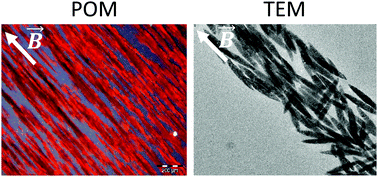Liquid crystalline phases from polymer functionalized ferri-magnetic Fe3O4 nanorods†
Abstract
Here, we present the surface functionalization of anisotropic in form ferri-magnetic Fe3O4-nanorods (NRs) with a diblock copolymer, having a PMMA- or PDEGMEMA-block, for solubilization, and a dopamine anchor block. These polymers were synthesized through RAFT polymerization via a macro-initiator approach. The successful surface functionalization, performed via a grafting-to method, was monitored using TGA, IR and TEM measurements. The NRs were very soluble in organic solvents after functionalization. Afterwards, the liquid crystalline (LC) behavior was investigated. During solvent evaporation, birefringent domains were formed. The self-assembly into lyotropic LC structures could be observed with PEG 400 as a non-evaporating solvent. Thereby the anisotropic in form NRs aligned themselves along a director without the loss of mobility, as observed in POM, TEM and SEM images. Magnetic fields have a strong influence on the LC phases formed. They not only lead to macroscopic orientation, but also to phase separation into highly concentrated LC phases and an isotropic phase, mostly free of NRs. This can be reversed by demagnetizing the nanoparticles. We also investigated PDEGMEMA-functionalized NRs with excess PDEGMEMA polymer as solvent, and liquid crystalline phases were also observed.

- This article is part of the themed collection: International Year of the Periodic Table: Applications for magnetic materials


 Please wait while we load your content...
Please wait while we load your content...